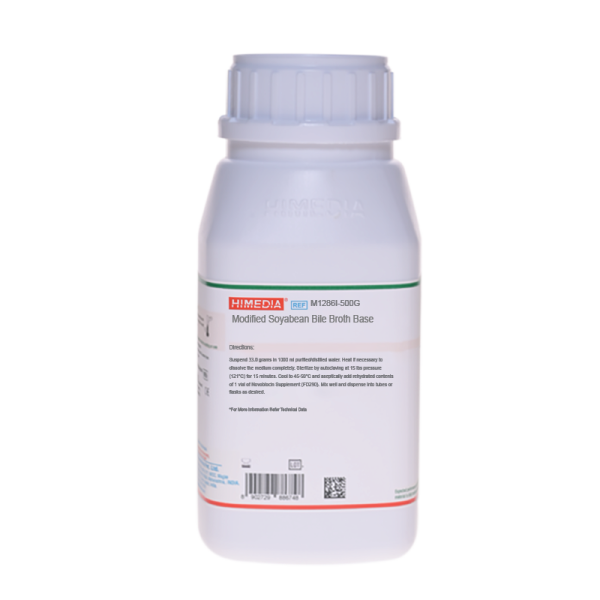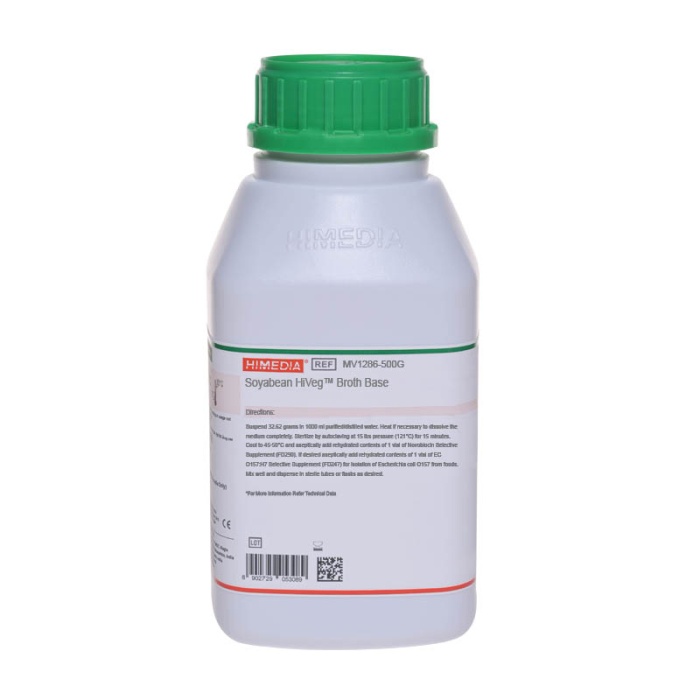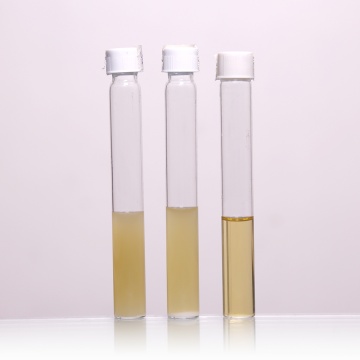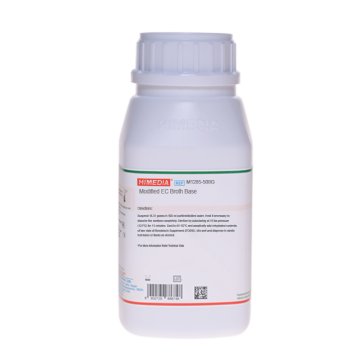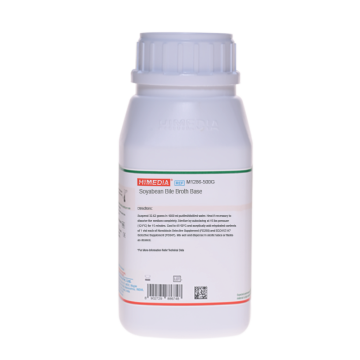 Your enquiry has been submitted
Your enquiry has been submitted
Modified Soyabean Bile Broth Base
Lactose fermenters#CC293D
Intended use
Modified Soyabean Bile Broth Base is an enrichment medium for the detection of Escherichia coli O157:H7 from food and animal feeding stuffs. The composition and performance criteria of this medium are as per the specifications laid down in ISO 16654:2001, Amd 2:2023, ISO 11133:2014 (Ε).
Composition
| Ingredients | g/L |
|---|---|
| Tryptone# | 17.000 |
| Soya peptone | 3.000 |
| D-Glucose (Dextrose) | 2.500 |
| Bile salts mixture | 1.500 |
| Dipotassium hydrogen phosphate | 4.000 |
| Sodium chloride | 5.000 |
Final pH (at 25°C): 7.3±0.2
**Formula adjusted, standardized to suit performance parameters # Equivalent to enzymatic digest of casein
Directions
Suspend 16.5 grams in 500 ml purified / distilled water. Heat if necessary to dissolve the medium completely. Sterilize by autoclaving at 15 lbs pressure (121°C) for 15 minutes. Cool to 45-50°C and aseptically add rehydrated contents of one vial of NO 20 Selective Supplement (FD290). Mix well and dispense as desired.
Principle And Interpretation
Escherichia coli is commonly found in the gut of humans and warm-blooded animals. In humans, it is found in several intestinal and extra-intestinal infections. Based on the virulence properties, different strains are divided into Enterotoxigenic (ETEC), Enteropathogenic (EPEC), Enteroinvasive (EIEC), Verotoxigenic (VTEC) and Enterohaemorragic (EHEC). Escherichia coli O157:H7 is an Enterohaemorragic strain implicated in foodborne illness. Due to severe nature of the clinical symptoms and the high contagiousness of the pathogens, the detection of EHEC is constantly gaining more and more clinical relevance (1,2). Modified Soyabean Bile Broth Base is formulated as recommended by FDA (3) for the enrichment and isolation of E.coli O157:H7. Modified Soyabean Bile Broth Base was subsequently accepted by ISO Committee as an enrichment medium for the detection and isolation of E.coli O157:H7 under the specification ISO/DIS 16654: 1999 (4).
Casitose and soya peptone provide carbonaceous, nitrogenous compounds, long chain amino acids and other essential growth nutrients. D-Glucose is the fermentable carbohydrate and energy source. Bile salts mixture inhibits gram-positive bacteria. Sodium chloride maintains osmotic equilibrium while phosphate buffers the medium well. Novobiocin renders the medium selectivity. Whenever low levels of E.coli O157:H7 are suspected, the food is enriched in Modified Soyabean Bile Broth and further plated on selective medium as Sorbitol MacConkey Agar (M2981) or Hemorrhagic coli (HC) Agar (M1158) for isolation and identification.
Blend 25 grams food sample to be tested in 224 ml Modified Soyabean Bile Broth and incubate with shaking (about 100 rpm) at 37°C for 18-24 hours. Prepare dilution of the enrichment culture with phosphate buffer and spread 0.1 ml of each dilution on HC Agar plates and incubate at 43°C for 24 hours.
Type of specimen
Food samples.
Specimen Collection and Handling
ISO 16654:2001&/Amd 2:2023 (4)
- Enrichment of the test portion homogenized in Modified Soyabean Bile Broth Base (M1286I) with incubation at 41.5±1°C for 6 h and subsequently for a further 12 h to 18h
- Isolation onto MacConkey Sorbitol Agar Base (M2981). Incubate at 37±1°C for 21±3h. Confirm the colonies by biochemical characterization.
Warning and Precautions :
Read the label before opening the container. Wear protective gloves/protective clothing/eye protection/ face protection. Follow good microbiological lab practices while handling specimens and culture. Standard precautions as per established guidelines should be followed while handling specimens. Safety guidelines may be referred in individual safety data sheets.
Limitations :
- Further subculture must be carried out for confirmation.
Performance and Evaluation
Performance of the medium is expected when used as per the direction on the label within the expiry period when stored at recommended temperature.
Quality Control
Appearance: Cream to yellow homogeneous free flowing powder
Colour and Clarity of prepared medium: Light amber coloured clear solution
Reaction: Reaction of 3.3% w/v aqueous solution at 25°C. pH: 7.3±0.2
pH: 7.10-7.50
Cultural Response
Cultural characteristics observed after an incubation at 41.5±1°C for 6 hours for productivity and for 21+ 3 hours for selectivity testing for (M12861), at 37±1°C for 21±3h (M2981) with added NO 20 Selective Supplement (FD290).
| Organism | Inoculum (CFU) | Growth (on M12861) |
|---|---|---|
| Productivity | ||
| Escherichia coli O157:H7 NCTC 12900 | 50-100 | >10 Characteristic colonies on M2981 |
| +Staphylococcus aureus subsp. aureus ATCC 25923 (00034*) | ||
| +Staphylococcus aureus subsp. aureus ATCC 6538 (00032*) | ||
| Selectivity | ||
| Staphylococcus aureus subsp. aureus ATCC 25923 (00034*) | >=104 | Total inhibition on M290 |
| Staphylococcus aureus subsp. aureus ATCC 6538 (00032*) | >=104 | Total inhibition on M290 |
| Organism | Inoculum (CFU) | Growth on M2981 | Colour of colony |
|---|---|---|---|
| Productivity | |||
| Escherichia coli O157:H7 NCTC 12900 | 50-100 | Good | Transparent colonies with a pale yellowish-brown appearance |
| Staphylococcus aureus subsp. aureus ATCC 25923 (00034*) | >=104 | Total inhibition | |
| Staphylococcus aureus subsp. aureus ATCC 6538 (00032*) | >=104 | Total inhibition | |
| Selectivity | |||
| Escherichia coli ATCC 25922 (00013*) | >=104 | Partial inhibition w/ growth of some pink colonies | |
| Escherichia coli ATCC 8097 (00012*) | >=104 | Partial inhibition w/ growth of some pink colonies | |
Key *- Corresponding WDCM numbers
Storage and Shelf Life
Store between 10-30°C in a tightly closed container and the prepared medium at 2-8°C. Use before expiry date on the label. On opening, product should be properly stored dry, after tightly capping the bottle in order to prevent lump formation due to the hygroscopic nature of the product. Improper storage of the product may lead to lump formation. Store in dry ventilated area protected from extremes of temperature and sources of ignition Seal the container tightly after use. Product performance is best if used within stated expiry period.
Disposal
User must ensure safe disposal by autoclaving and/or incineration of used or unusable preparations of this product. Follow established laboratory procedures in disposing of infectious materials and material that comes into contact with sample must be decontaminated and disposed of in accordance with current laboratory techniques (5,6).
References
- Karmali M. A., Petric M., Lim C. et al, 1985, J. Infect. Dis., 151:775.
- Szabo R. A., Todd E. C., Ean, A., 1986, Method to isolate E. coli O157:H7 from food, J. Food Prot., 10;768-772.
- FDA Bacteriological Analytical Manual, 2005, 18th Ed., AOAC, Washington,D.C.
- Microbiology of food and animal feeding stuffs – Horizontal method for the detection of Escherichia coli O157 AMENDMENT 2: Inclusion of performance testing of all culture media and reagents, ISO 16654:2001, Amd 2:2023.
- Isenberg, H.D. Clinical Microbiology Procedures Handbook. 2nd Edition.
- Jorgensen, J.H., Pfaller, M.A., Carroll, K.C., Funke, G., Landry, M.L., Richter, S.S and Warnock., D.W.(2015) Manual of Clinical Microbiology, 11th Edition. Vol. 1.
| Product Name | Modified Soyabean Bile Broth Base |
|---|---|
| SKU | M1286I |
| Product Type | Regular |
| Physical Form | Powder |
| Origin | Animal |
| Packaging type | HDPE |
| References | 1. FDA Bacteriological Analytical Manual, 2005, 18th Ed., AOAC, Washington, D.C. |
| Customized Product Available | No |



